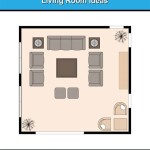Living Room Furniture Floor Plans
Arranging living room furniture can be a daunting task, but it's essential to create a space that is both functional and inviting. A well-planned floor plan will help you maximize space, improve flow, and create a cohesive look.
There are several basic furniture arrangements that can serve as a starting point for your own unique design. The most common include:
- Conversational Grouping: This arrangement centers around a focal point, such as a fireplace or television, and includes seating that faces each other, encouraging conversation.
- L-Shaped Arrangement: This layout uses two sofas or a sofa and loveseat placed perpendicular to each other, creating a cozy and intimate atmosphere.
- U-Shaped Arrangement: Similar to the L-shaped arrangement, this layout includes three seating pieces arranged in a U-shape, providing ample seating for larger gatherings.
- Parallel Arrangement: This arrangement places two sofas or loveseats opposite each other, creating a more formal and symmetrical look.
- Sectional Arrangement: Sectional sofas offer a versatile and modular way to create a custom layout that suits your specific needs and space.
Once you have selected a basic layout, it's time to consider the following factors to fine-tune your floor plan:
- Focal Point: Identify a focal point in the room, such as a fireplace, window, or entertainment center, and arrange furniture around it to create a sense of balance and interest.
- Traffic Flow: Ensure that there is ample space for people to move around the room without bumping into furniture. Leave at least 3 feet of clearance between seating and walkways.
- Seating Orientation: Consider the orientation of seating based on the primary activities in the room. For example, if you primarily watch television, face the seating towards the screen.
- Furniture Scale: Choose furniture pieces that are appropriately sized for the room. Oversized furniture can make a small room feel cramped, while undersized furniture can get lost in a large space.
- Symmetry and Balance: Create a sense of harmony by arranging furniture symmetrically or by balancing the weight of the pieces on either side of the room.
- Functionality: Consider the practical aspects of furniture placement. For example, place tables within reach of seating, and ensure that there is sufficient lighting for all activities.
Remember that furniture arrangement is not a one-size-fits-all solution. The best floor plan for your living room will depend on its specific dimensions, shape, and intended use. Experiment with different arrangements until you find one that meets your needs and creates a welcoming and functional space.
:strip_icc()/100185277-720ea7a9044a47ed96ed87d0b159b6a1.jpg?strip=all)
Living Room Layouts To Make The Most Of Your Gathering Space

How To Arrange Furniture In A Family Room Decorate

How To Arrange Furniture With A Floor Planning Tool

Living Room Floor Plans Types Examples Considerations Cedreo

Open Concept Living How To Arrange Your Furniture In One Big Space Nest Interior Design

10 Ideal Dimension Of Living Room Sofa

How To Arrange Furniture In Architectural Spaces 7 Essential Tips Archdaily

How To Create A Floor Plan And Furniture Layout Hgtv

4 Furniture Layout Floor Plans For A Small Apartment Living Room Tips Forrent

Furniture Placement In A Large Room How To Decorate








